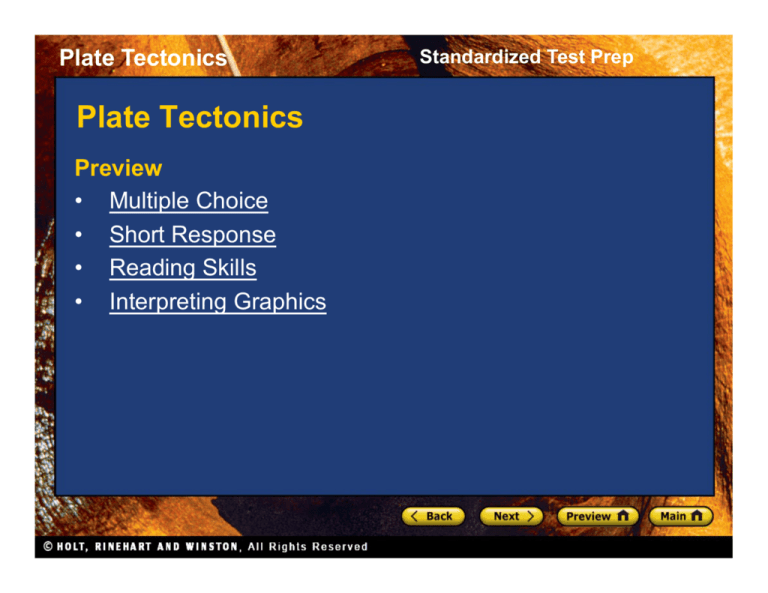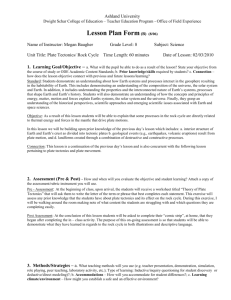Read-Only - Elliott County Schools
advertisement

Plate Tectonics Plate Tectonics Preview • Multiple Choice • Short Response • Reading Skills • Interpreting Graphics Standardized Test Prep Plate Tectonics Standardized Test Prep Multiple Choice 1. Which of the following factors is most important when determining the type of collision that forms when two lithospheric plates collide? A. B. C. D. the density of each plate the size of each plate the paleomagnetism of the rock the length of the boundary Plate Tectonics Standardized Test Prep Multiple Choice, continued 1. Which of the following factors is most important when determining the type of collision that forms when two lithospheric plates collide? A. B. C. D. the density of each plate the size of each plate the paleomagnetism of the rock the length of the boundary Plate Tectonics Standardized Test Prep Multiple Choice, continued 2. At locations where sea-floor occurs, rock is moved away from a mid-ocean ridge. What replaces the rock as it moves away? F. G. H. I. molten rock older rock continental crust compacted sediment Plate Tectonics Standardized Test Prep Multiple Choice, continued 2. At locations where sea-floor occurs, rock is moved away from a mid-ocean ridge. What replaces the rock as it moves away? F. G. H. I. molten rock older rock continental crust compacted sediment Plate Tectonics Standardized Test Prep Multiple Choice, continued 3. Which of the following was a weakness of Wegener s proposal of continental drift when he first proposed the hypothesis? A. B. C. D. an absence of fossil evidence unsupported climatic evidence unrelated continent features a lack of proven mechanisms Plate Tectonics Standardized Test Prep Multiple Choice, continued 3. Which of the following was a weakness of Wegener s proposal of continental drift when he first proposed the hypothesis? A. B. C. D. an absence of fossil evidence unsupported climatic evidence unrelated continent features a lack of proven mechanisms Plate Tectonics Standardized Test Prep Multiple Choice, continued 4. Which of the following statements describes a specific type of continental growth? F. Continents change not only by gaining material but also by losing material. G. Terranes become part of a continent at convergent boundaries. H. Ocean sediments move onto land because of seafloor spreading. I. Rifting adds new rock to a continent and causes the continent to become wider. Plate Tectonics Standardized Test Prep Multiple Choice, continued 4. Which of the following statements describes a specific type of continental growth? F. Continents change not only by gaining material but also by losing material. G. Terranes become part of a continent at convergent boundaries. H. Ocean sediments move onto land because of seafloor spreading. I. Rifting adds new rock to a continent and causes the continent to become wider. Plate Tectonics Standardized Test Prep Short Response 5. What is the name for the process by which the Earth s crust breaks apart? rifting Plate Tectonics Standardized Test Prep Short Response, continued 6. What is the name for the layer of plastic rock directly below the lithosphere? Plate Tectonics Standardized Test Prep Short Response, continued 6. What is the name for the layer of plastic rock directly below the lithosphere? the asthenosphere Plate Tectonics Standardized Test Prep Reading Skills Read the passage below. Then, answer questions 7–9. The Himalaya Mountains The Himalaya Mountains are a range of mountains that is 2,400 km long and that arcs across Pakistan, India, Tibet, Nepal, Sikkim, and Bhutan. The Himalaya Mountains are the highest mountains on Earth. Nine mountains in the chain, including Mount Everest, the tallest above-water mountain on Earth, rise to heights of more than 8,000 m above sea-level. Mount Everest stands 8,850 m tall. The formation of the Himalaya Mountains began about 80 million years ago. A tectonic plate carrying the Indian subcontinent collided with the Eurasian plate. The Indian plate was denser than the Eurasian plate. This difference in density caused the uplifting of the Eurasian plate and the subsequent formation of the Himalaya Mountains. This process continues today. The Indian plate continues to push under the Eurasian plate. New measurements show that Mount Everest is moving to the northeast by as much as 10 cm per year. Plate Tectonics Standardized Test Prep Reading Skills, continued 7. According to the passage, what geologic process formed the Himalaya Mountains? A. B. C. D. divergence continental drift strike-slip faulting convergence Plate Tectonics Standardized Test Prep Reading Skills, continued 7. According to the passage, what geologic process formed the Himalaya Mountains? A. B. C. D. divergence continental drift strike-slip faulting convergence Plate Tectonics Standardized Test Prep Reading Skills, continued 8. Which of the following statements is a fact according to the passage? F. The nine tallest mountains on Earth are located in the Himalaya Mountains. G. The Himalaya Mountains are the longest mountain chain on Earth. H. The Himalaya Mountains are located within six countries. I. The Himalaya Mountains had completely formed by 80 million years ago. Plate Tectonics Standardized Test Prep Reading Skills, continued 8. Which of the following statements is a fact according to the passage? F. The nine tallest mountains on Earth are located in the Himalaya Mountains. G. The Himalaya Mountains are the longest mountain chain on Earth. H. The Himalaya Mountains are located within six countries. I. The Himalaya Mountains had completely formed by 80 million years ago. Plate Tectonics Standardized Test Prep Reading Skills, continued 9. Which plate is being subducted along the fault that formed the Himalaya Mountains? A. B. C. D. The Indian plate is being subducted. The Eurasian plate is being subducted. Both plates are being equally subducted. Neither plate is being subducted. Plate Tectonics Standardized Test Prep Reading Skills, continued 9. Which plate is being subducted along the fault that formed the Himalaya Mountains? A. B. C. D. The Indian plate is being subducted. The Eurasian plate is being subducted. Both plates are being equally subducted. Neither plate is being subducted. Plate Tectonics Standardized Test Prep Interpreting Graphics Use the map below to answer questions 10 and 11. The map shows the locations of the Earth s major tectonic plate boundaries. Plate Tectonics Standardized Test Prep Interpreting Graphics, continued 10. What type of boundary is found between the South American plate and the African Plate? A. B. C. D. convergent divergent transform subduction Plate Tectonics Standardized Test Prep Interpreting Graphics, continued 10. What type of boundary is found between the South American plate and the African Plate? A. B. C. D. convergent divergent transform subduction Plate Tectonics Standardized Test Prep Interpreting Graphics, continued 11. What type of boundary is found between the South American plate and the African plate? What surface features are most often at boundaries of this type? Answers should include: the boundary between the South American plate and the African plate is a divergent boundary; most divergent boundaries are located on the ocean floor and produce mid-ocean ridges and underwater mountain ranges Plate Tectonics Standardized Test Prep Interpreting Graphics, continued Use the graphic below to answer questions 12 and 13. The graphic shows a strike-slip fault along a transform boundary. Plate Tectonics Standardized Test Prep Interpreting Graphics, continued 12. What type of crustal interaction is indicated by the letter E? F. G. H. I. continental rifting sea-floor spreading divergence subduction Plate Tectonics Standardized Test Prep Interpreting Graphics, continued 12. What type of crustal interaction is indicated by the letter E? F. G. H. I. continental rifting sea-floor spreading divergence subduction Plate Tectonics Standardized Test Prep Interpreting Graphics, continued 13. Describe how a transform boundary differs from the boundaries shown by letters D and E in terms of plate movement and magmatic activity. Answers should include: unlike the plates at a convergent boundary, shown by letter E, or divergent boundary, shown by letter D, plates at a transform boundary move past one another, not into or away from one another; transform boundaries produce a number of earthquakes, but they do not produce magma or cause mountain formation






